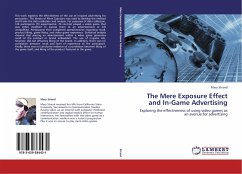This work explores the effectiveness of the use of in-game advertising for persuasion. The theory of Mere Exposure was used to develop the method and frame the data collection and analysis. For purposes of data collection, 143 participants (73 experimental, 70 control) played a video game that was either modified to expose them to an advertisement or left unmodified. Participants then completed questionnaires regarding recall, product liking, game liking, and video game experience. Statistical analysis showed that placing an advertisement within a video game generates recall of the product or brand embedded. The use of in-game ads, however, did not influence liking of the brand. In addition, there was no correlation between recall and level of experience of the participant. Finally, there was no conclusive evidence of a correlation between liking of the game itself, and liking of the product featured in the game.
Bitte wählen Sie Ihr Anliegen aus.
Rechnungen
Retourenschein anfordern
Bestellstatus
Storno








